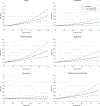Association of Higher Consumption of Foods Derived From Subsidized Commodities With Adverse Cardiometabolic Risk Among US Adults
- PMID: 27379488
- PMCID: PMC6512298
- DOI: 10.1001/jamainternmed.2016.2410
Association of Higher Consumption of Foods Derived From Subsidized Commodities With Adverse Cardiometabolic Risk Among US Adults
Abstract
Importance: Food subsidies are designed to enhance food availability, but whether they promote cardiometabolic health is unclear.
Objective: To investigate whether higher consumption of foods derived from subsidized food commodities is associated with adverse cardiometabolic risk among US adults.
Design, setting, and participants: Cross-sectional analysis of the National Health and Nutrition Examination Survey data from 2001 to 2006. Our final analysis was performed in January 2016. Participants were 10 308 nonpregnant adults 18 to 64 years old in the general community.
Exposure: From a single day of 24-hour dietary recall in the National Health and Nutrition Examination Survey, we calculated an individual-level subsidy score that estimated an individual's consumption of subsidized food commodities as a percentage of total caloric intake.
Main outcomes and measures: The main outcomes were body mass index (calculated as weight in kilograms divided by height in meters squared), abdominal adiposity, C-reactive protein level, blood pressure, non-high-density lipoprotein cholesterol level, and glycemia.
Results: Among 10 308 participants, the mean (SD) age was 40.2 (0.3) years, and a mean (SD) of 50.5% (0.5%) were male. Overall, 56.2% of calories consumed were from the major subsidized food commodities. United States adults in the highest quartile of the subsidy score (compared with the lowest) had increased probabilities of having a body mass index of at least 30 (prevalence ratio, 1.37; 95% CI, 1.23-1.52), a ratio of waist circumference to height of at least 0.60 (prevalence ratio, 1.41; 95% CI, 1.25-1.59), a C-reactive protein level of at least 0.32 mg/dL (prevalence ratio, 1.34; 95% CI, 1.19-1.51), an elevated non-high-density lipoprotein cholesterol level (prevalence ratio, 1.14; 95% CI, 1.05-1.25), and dysglycemia (prevalence ratio, 1.21; 95% CI, 1.04-1.40). There was no statistically significant association between the subsidy score and blood pressure.
Conclusions and relevance: Among US adults, higher consumption of calories from subsidized food commodities was associated with a greater probability of some cardiometabolic risks. Better alignment of agricultural and nutritional policies may potentially improve population health.
Conflict of interest statement
Figures
Comment in
-
How Society Subsidizes Big Food and Poor Health.JAMA Intern Med. 2016 Aug 1;176(8):1132-3. doi: 10.1001/jamainternmed.2016.3068. JAMA Intern Med. 2016. PMID: 27380490 No abstract available.
References
-
- Agriculture and Consumer Protection Act of 1973. Pub L No. 93–86, 87 Stat 221.
-
- Ogden CL, Carroll MD, Flegal KM. Prevalence of obesity in the United States. JAMA 2014;312(2): 189–190. - PubMed
-
- Mozaffarian D, Benjamin EJ, Go AS, et al.; American Heart Association Statistics Committee and Stroke Statistics Subcommittee. Heart disease and stroke statistics: 2015 update: a report from the American Heart Association [published correction appears in Circulation. 2015;131(24):e535.]. Circulation 2015;131(4):e29–e322. doi:10.1161/CIR.0000000000000152. - DOI - PubMed
-
- Glickman D, Veneman AM. The essential role of food and farm policy in improving health. Health Aff (Millwood) 2013;32(9):1519–1521. - PubMed
-
- Mozaffarian D, Fahimi S, Singh GM, et al.; Global Burden of Diseases Nutrition and Chronic Diseases Expert Group. Global sodium consumption and death from cardiovascular causes. N Engl J Med 2014;371(7):624–634. - PubMed
MeSH terms
Substances
Grants and funding
LinkOut - more resources
Full Text Sources
Other Literature Sources
Medical
Research Materials


